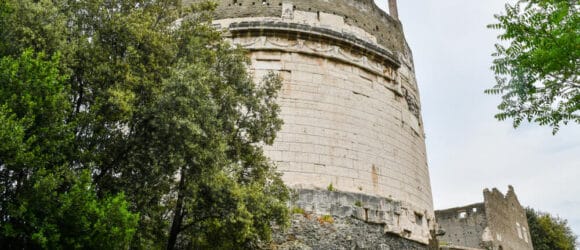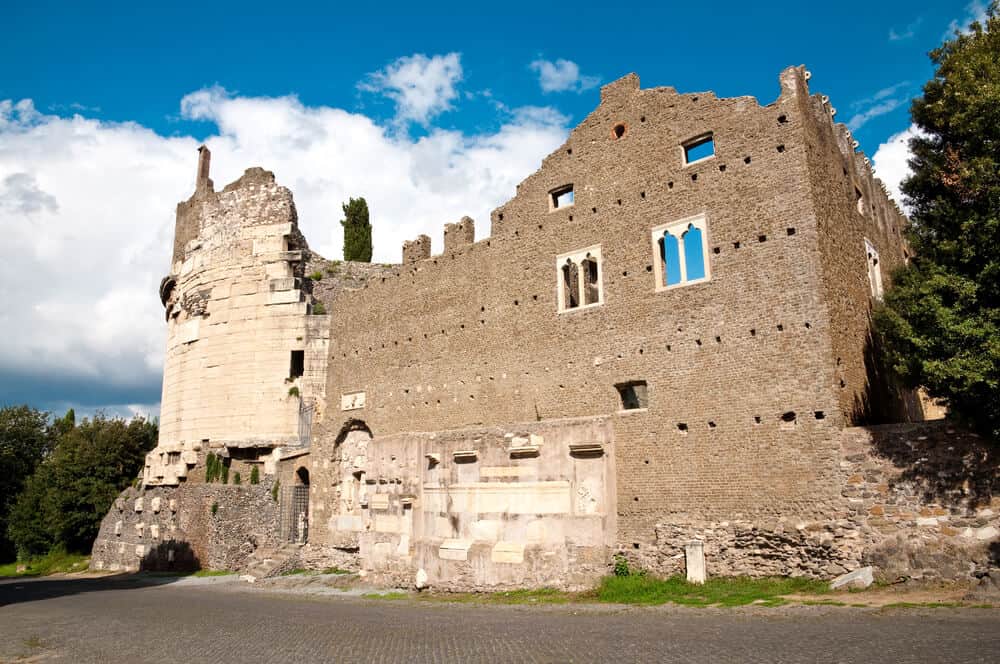Visiting the Mausoleum of Cecilia Metella: A Guide to Rome’s Ancient Tomb

The Mausoleum of Cecilia Metella is an ancient tomb built in the 1st century BC. The tomb holds the remains of Cecilia Metella (sometimes Caecilia Metella), who was a member of the prominent Metella family in ancient Rome, known for their significant political and social influence. Despite the limited historical records about her personal life, her tomb is a grand testament to her family’s wealth and status, symbolizing the enduring legacy of the Metella lineage in Roman history.
Keep reading to learn more about the Caecilia Metella tomb – including its design and how to visit this remarkable site near the Eternal City.
History and Significance of the Caecilia Metella Tomb
The construction of the Mausoleo di Cecilia Metella was completed around 50 BC. The mausoleum was commissioned by Crassus, a wealthy Roman general, for his daughter-in-law, Cecilia Metella (the wife of his son, Marcus Crassus). The mausoleum is a testament to the wealth of one of the most influential Roman families. It also highlights the Roman practice of commemorating the dead with grand monuments.
Over the centuries, it has served various purposes, including as a fortress for the Caetani family during the Middle Ages. The family was related to Pope Boniface VIII and used the structure to frighten passing traffic into paying a toll. Today, the mausoleum remains a well-preserved testament to the architecture and design of the time.
Structure and Design
This cylindrical drum tomb, made of travertine blocks and tufa, rises from a square base and is adorned with intricate friezes depicting scenes of military triumphs and pastoral life. It looks like the main tower of a castle from afar. It is decorated at the top by a marble frieze of garland and ox skulls. The presence of these reliefs refers to the region “Capo di Bove,” which translates to “Hamlet of the Heads of the Ox and Cow.” At the entrance, there is an inscription with the name of Cecilia Metella.
Location
The mausoleum is located on the historic Appian Way, also known as Via Appia Antica in Italian. The Appian Way is one of the oldest and most important roads of ancient Rome and stretches from Rome to the port city of Brindisi in southeastern Italy. The road played a crucial role in military and economic transportation, facilitating the movement of troops, goods, and information across the Roman Republic and later the Empire.
The Appian Way is renowned for its straight, well-engineered layout and is lined with historical sites, including tombs, ruins, and ancient monuments. It is a significant cultural and archaeological treasure that offers insight into Roman engineering and civilization.
Visiting Ancient Rome
Buses from central Rome stop at the site. You can also drive, but limited parking is available along the Appian Way. Some visitors rent bikes or take a leisurely walk to enjoy the scenic surroundings. Early morning or late afternoon are the best times to visit to avoid the midday heat and crowds. Entry to the mausoleum is included in the Appia Antica archaeological park ticket.
When you arrive, you’ll be able to marvel at the massive, well-preserved walls and the intricate frieze that encircles the tomb. The interior is not always open to the public, but if accessible, it offers a chance to see the burial chamber and the impressive stonework up close.
Visiting the Mausoleum of Cecilia Metella is a journey through time. As you visit this majestic tomb, consider its purpose. It was built to celebrate the life of a great family and as a love offering from the deceased’s husband.
What type of monument will you leave behind to celebrate your family’s accomplishments? Consider building a private family mausoleum as your final resting place. Eternal Mausoleums by Forever Legacy is North America’s premier builder of private mausoleums. Our staff is dedicated to making a beautiful space that your family will be proud to visit for generations. Request a consultation today to learn more.

